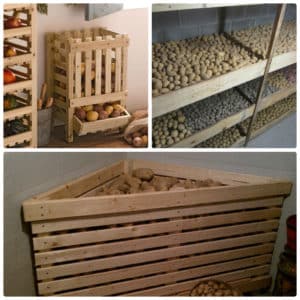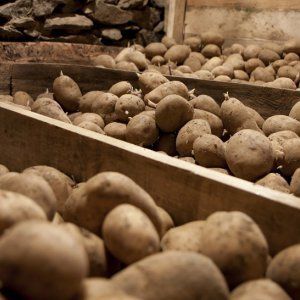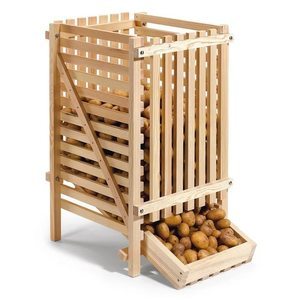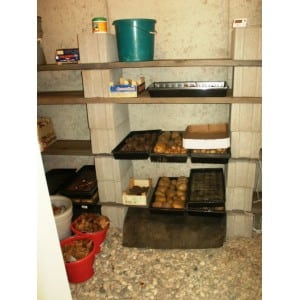Rules for storing potatoes in the cellar
In your own home, and even sometimes in the city, potatoes are stored in a cellar - a separate dry room with constant temperature and humidity, where better conditions can be created. However, there are nuances even in such a simple matter as storing vegetables in a cellar: are all potatoes suitable for such storage, how exactly to lay them out, what should the air parameters be? So, let's figure out how to store it correctly potatoes in the cellar in winter.
Which potato varieties are suitable for long-term storage?
Before storing potatoes in the cellar for a long time storage, make sure you have the right variety for this. Not every variety is suitable for being kept for many months without processing.
Pay attention to the following criteria:
- The main enemy of long-term storage is moisture, therefore, the more dry matter in the tubers, the longer they last. Thus, the first selection criterion long-lasting variety - high starch content.
- Potatoes are stored in the fall after the final harvest. Therefore, the later the potatoes ripen, the longer they are stored. The second criterion is whether the variety belongs to mid- or late-ripening.
- The third criterion is disease resistance. Such a common potato disease as late blight can destroy half the crop, even if suitable conditions are created in the cellar. Pre-cleaning the tops from the garden beds slightly reduces the likelihood of infection before starting digging potatoes.
Due to climatic conditions in Russia, late potato varieties are more often grown in the southern regions. There he manages to safely go through the entire growing season - 110-140 days.
So, according to the listed criteria, several varieties can be distinguished that tolerate long-term storage in the cellar particularly well. These include:
- Bronnitsky. Brought out in the late 80s of the 20th century in the Leningrad region. Disease resistant and very tasty. This mid-season variety produces large tubers with light yellow skin. The keeping quality of the variety is estimated at 95%.
- Blue. This is a late-ripening variety with tubers with yellow skin and white flesh. Developed in the 90s of the 20th century for the Central Black Earth regions and regions in the Volga waters. Keeping quality - 90-95%.
- Crane. The mid-late variety was bred in Belarus and distributed in Russia. Very productive, resistant to weather changes, not afraid of most nightshade diseases. The tubers are red, the flesh is light yellow.
- Lorch. Grown in central Russia and the south. The tubers are yellow in color and ripen 120-140 days after planting (late ripening). Contains a lot of starch.
- Gull. This productive variety is acclimatized for the northwestern regions of our country, however, it is late ripening. Light yellow tubers with cream-colored flesh. Keeping quality - 92%.
When organizing storage, it is also important how the potatoes were grown:
- How rainy the summer was is also important. If it was very wet, then the tubers will contain a lot of moisture and will be stored much worse.

- Potatoes grow best in light, non-clay soil mixed with sand.A vegetable grown on peat or black soil is unlikely to survive intact until spring.
- Potatoes grown with large amounts of fertilizers, in particular nitrogenous ones, do not tolerate prolonged storage in the cellar. Too much nitrogen causes sugars to be deposited in tubers and increases the likelihood of disease and pest infestation. Potatoes overfed with fertilizers are easy to identify - they have thin skins and watery cores. At the same time, when growing, it is important to provide the plant with a sufficient amount of potassium in the soil. If this substance is not enough, the potatoes will also not be stored well.
- The harvest harvested too early will also fail. The peel of this vegetable is too thin to provide it with protection from damage and disease.
When to put potatoes in the cellar
Since each of these varieties has its own ripening period, their harvesting time in the cellar is also different. In addition, you need to prepare the storage room and the tubers themselves.
How to prepare a cellar
The optimal constant temperature is 2-4°C. Constant humidity is also extremely important - 80-90% - as well as protection from water ingress.
Attention! Since the tubers “breathe” and emit carbon dioxide, ventilation must be provided in the room.
The cleanliness of the cellar is of great importance, so it is pre-treated.
Treatment
All unnecessary things are thrown out of the cellar, garbage is removed, and the floor is swept. Shelves on which to store boxes with potatoes, put in the sun and dried. They are then treated with antifungal drugs. The walls and ceiling are inspected for the presence of mouse and rat passages; if there are any, they are filled with cement. After this, the walls and ceiling are treated with lime.
After all these steps, the cellar is left open to dry for 3-4 days.
Preparing the storage container
If potatoes are stored in wooden boxes or pallets, they are inspected for damage and replaced with new ones if necessary. Then the boxes are cleaned of soil and other contaminants and washed with soapy water. After this they are dried in the sun.
Tuber preparation
After harvesting from the field, the tubers should, firstly, be dried. This is done to remove excess moisture and reduce morbidity. At first, the harvested tubers are dried directly in the garden for about two hours. Then they are laid out in a cool room (about +15°C) and left there for two weeks - during this time the peel hardens.
Then the potatoes are cooled, gradually (every two days) lowering the room temperature by 1°C. The final temperature should be +1°C.
Storage methods in the cellar
So, the potato tubers and the room are prepared for long-term storage; it’s time to choose in what form they will be in the cellar. There are several options: store vegetables in boxes, in bags, in nets, in closed containers, or simply in bulk. Let's look at each storage method.
In wooden boxes

It is convenient and correct when potato storage boxes are placed on racks or pallets. Two drawers are placed on a shelf; they are not placed close to each other, but keeping a certain distance: 5 cm between the drawers and 3 cm from the wall.
Coniferous wood is more suitable for boxes; the distance between the slats is approximately 4 cm.
In natural fabric bags
Most often, potatoes are stored in canvas bags. This method allows the tubers to breathe, not get overcooled and not become damp. There should be a distance of 5-10 cm between the bags.The bags are also placed on pallets.
In bulk
You can store potatoes simply by scattering them on trays. But in this case, fruit rotting is possible due to poor air exchange.
In grids
Potato tubers are often stored in nets, which are again placed on pallets. However, in this case, the nets with potatoes must be covered on top with a layer of straw or old jackets so that the tubers do not freeze.
Requirements for temperature and humidity
At what temperature should the cellar with potatoes be closed for the winter? The optimal temperature is considered to be from +2 to +5°C and humidity not higher than 95%.
How to protect from moisture and freezing
The enemies of long-term storage of vegetables are excess moisture and cold. What can you do to protect your potatoes from getting damp? You can place beets on top of it, which will absorb excess moisture. Maintaining a constant temperature in the cellar, as well as thermal insulation of the room itself, will protect you from the cold.
How to store seed tubers in the cellar
In order for seed potatoes to retain all their qualities, before storing them in the cellar they are not only dried, but also greened, that is, left in the open air for a week. This treatment increases the resistance of tubers to diseases. After greening, the tubers are sorted out and damaged and diseased ones are thrown away.
Shelf life of potatoes
Provided all rules are followed, potatoes can be stored in the cellar until the new harvest. But usually by the beginning of the summer season the potatoes in the cellar are gone.
Attention! Late ripening varieties begin to break dormancy around March.
The most common mistakes
Despite the correct selection of varieties for storage, harvesting under suitable conditions and a properly equipped cellar, vegetables may still not survive until spring and may spoil.
This happens for several reasons:
- Storage temperature drops too quickly. If the temperature in the cellar is reduced too quickly, the starch in the potatoes quickly breaks down into sugar, the tuber is damaged, and the potatoes rot.
- Too infrequent sorting of tubers. During the entire storage period, it is necessary to periodically inspect the vegetables stored in the cellar and remove rotten or diseased ones. If this is not done, by spring it may turn out that the harvest is half lost.
- Storage temperature too low. In this case, the potatoes freeze slightly, which affects their taste and keeping quality.
- Tuber germination. So that in the spring, when the temperature outside rises, the potatoes do not germinate, the temperature in the cellar is lowered by 1°C, and the tubers again fall into a state of forced dormancy.
Conclusion
It is convenient to store potatoes in the cellar in winter, but it is important to know how to do it correctly. To ensure that the tubers last a long time, they are first dried, and the cellar is cleaned and treated with antifungal drugs and lime.
Not all varieties are suitable for long-term storage; late-ripening potatoes have the best shelf life. In addition, how and where it was grown and how it was collected also matters.